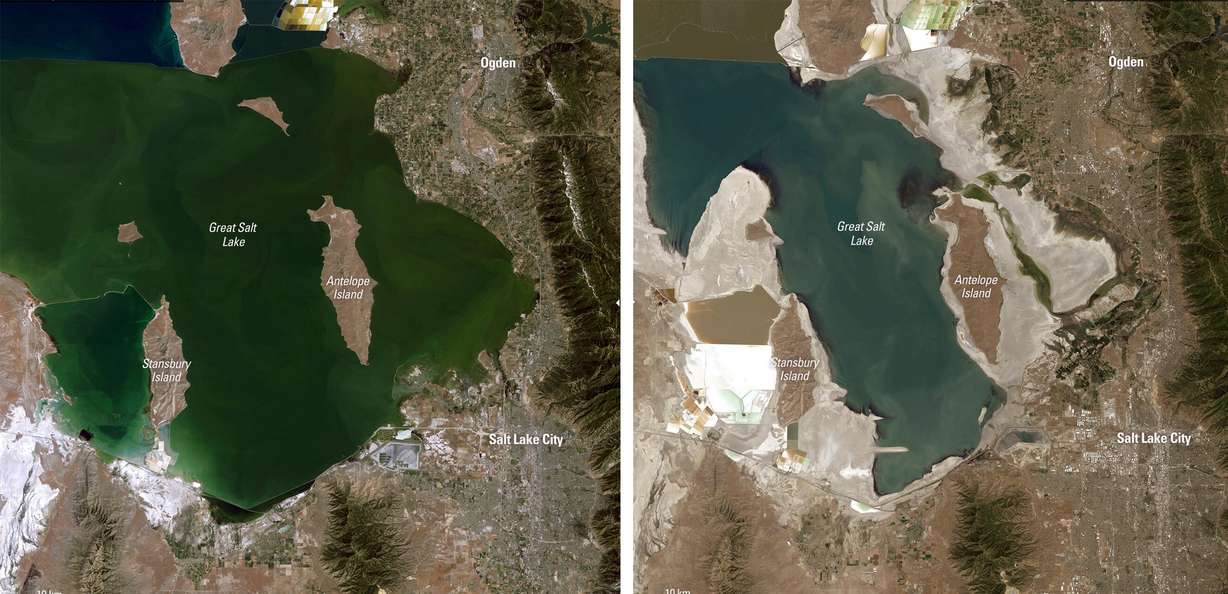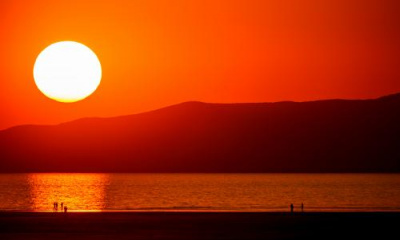SALT LAKE CITY — The Great Salt Lake attracts hundreds of thousands of visitors every year even if it's a shell of its old self.
For instance, more than 115,000 people have already visited the Great Salt Lake Marina State Park this year, while another three-quarters of a million people have visited nearby Antelope Island, per Utah Division of State Parks data updated through the end of September. These visitation statistics don't include the bays on the lake's eastern edge, which also draw scores of even more people.
And people often bring questions about the lake with them because, well, it's quite unique. There aren't many terminal saline lakes in the world, and certainly not the size of the Great Salt Lake. This long-standing curiosity resulted in the Utah Geological Survey publishing a booklet called "Commonly Asked Questions About Utah's Great Salt Lake And Ancient Lake Bonneville" in 1996, as a way to answer all the questions people routinely have about the lake.
It answers everything from questions about the lake's depth to its ecosystem and its chemical composition.
However, the size of the lake has drastically diminished in 26 years, dropping from its historical average of about 4,200 feet elevation in 1996 to a record low of 4,188 feet this year. Experts say the decline is a mixture of ongoing drought conditions and projects that divert the lake's tributaries from reaching the lake.
The decline has exposed hundreds of square miles of the lakebed. The Utah Division of Water Resources reported earlier this month that while the lake decline has stabilized for the winter, a new record low is expected again next year.
The booklet's cover is hardly recognizable. It's an aerial photo of Antelope Island taken in 1988, two years after the lake reached its highest level on record. Water levels have dropped so much that wildlife agencies began installing fences to prevent animals from getting to or leaving the island because it's not much of an island anymore.
Scientists and historians have also learned so much more about the lake over the past 26 years that the booklet was in need of an update. Mark Milligan, a geologist with the Utah Geological Survey, explained that the agency planned to update the booklet for some time but it prioritized a second edition when the lake reached record lows over the past two years, prompting all sorts of new frequently asked questions.
"It came to the top of the list because the lake has changed so much since 1996, and it's such a topic of interest right now," he said.
The second edition of the booklet is now available; the agency began selling it at its Natural Resources Map & Bookstore this week. It costs $8.50 for a print copy, though there's an online version available for free.
The update addresses the collapse of the Great Salt Lake and other recent findings which offer a better understanding of the lake today. That said, it likely doesn't paint a complete picture of the famous body of water because there's still plenty of research happening to answer even more questions.
"We hope that people (gain) a greater appreciation and its importance to all aspects of modern Utah — from the wildlife to the recreation to the mineral extraction industries to the brine shrimping industries," Milligan adds.
What's new in the second edition
The record-low lake levels — and the impact that has on the lake — are the obvious differences between the first and second editions; however, microbialites, or bioherms, are a perfect example of how researchers are still understanding different facets of the Great Salt Lake. These are sedimentary deposits at the bottom of the lake that are likened to a "living rock" in the booklet.
Milligan notes that those were known in the past only because they had been exposed in the early 1960s, which is when the lake reached its previous record-low prior to 2021. While known, researchers didn't spend much time researching them before the lake levels returned to normal. The record-low levels now have helped researchers get a better understanding of how they factor into the lake's ecosystem.
The booklet's authors delineate that bioherms inhabit "about one-fifth of the lakebed," making it the "largest expanse of these 'living rocks' on Earth." They offer a perfect nesting spot for brine flies to lay larvae on.
"The brine fly larvae graze on algae growing on the lake floor and so do not directly compete with brine shrimp for food that eat algae suspended in the water," they wrote. "The larvae then develop into pupae that attach to a hard substrate. After a few weeks, the adults emerge from the pupae casing, absorb, metabolize, and trap gas bubbles, and float to the surface."
The booklet also points out that mirabilite crystals become more visible by the lake when the lake levels are low, something learned from new research.
The lake should be appreciated for what it is. It's an amazing resource.
–Mark Milligan, geologist with the Utah Geological Survey
Then there are the different colors of the lake, which is a phenomenon caused by different salinity levels north and south of the current railroad causeway that was constructed in 1959. The northern arm typically turns a reddish-pinkish color because it holds more salt than the southern arm. In 2020, the northern arm's salinity levels bounced between 27% and 29%, while the southern arm's levels only reached as high as 16% — because freshwater tributaries dump into the southern arm, the authors of the booklet note.
This wasn't the case before because the salinity levels are about the same when the lake levels are higher.
The authors even explain that, no, there aren't fish in the lake. That said, there was a brief time in the 1980s that rainwater killifish invaded the water by Stansbury Island until the lake water fell again and its salinity increased, killing off the species.
There's also more information about the Spiral Jetty in the booklet. While Robert Smithson completed the 1,500-foot-long and 15-foot-wide rock art near Corinne in 1970, it quickly disappeared when the Great Salt Lake's water levels rose. It's now arguably the symbol of the lake's receding water levels, even becoming the state's official work of land art in 2017.
"It reappeared once or twice — a little bit — in the '90s, and then from 2002 on it's been exposed," Milligan said. "That wasn't in the original (edition) because it had been underwater for most of the time."
Why there will likely be more editions in the future
Researchers are only beginning to search for solutions to help the drying lake. Congressional arms approved a pair of bills that aim to study solutions for the Great Salt Lake and Great Basin saline lakes earlier this year.
The Utah State University Quinney College of Natural Resources is also on the case, among other local institutions, which may help Utah lawmakers come up with legislation that impacts what the lake looks like now.
No matter what happens in the future, Milligan said it's likely that there will be another edition of the book to document the changes.
"The lake should be appreciated for what it is," he said. "It's an amazing resource."








